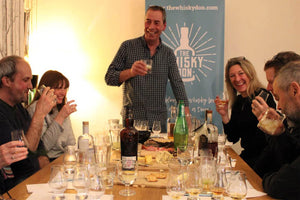Ogee, or not Ogee – That is the Question
Our Teaching Partner in Germany, Hans Strenge, offers some thoughts about one of the more elusive terms from the art of whisky distilling…
What is an ogee? I faintly remember the question popping up during a whisky quiz a couple of years ago. My first guess was that this was just another funny sounding word (for German ears) from the Scottish language like dram, fankle or dreich (possibly the opposite of the latter?). The answer we were given felt disappointingly profane: we were informed that an ogee was the pot's upper part of a pot still.
A couple of years later I came across a very different usage of the word; I then learned that an ogee was in fact a bulge (or boil ball) – a feature of a pot still to increase reflux. Since this was apparently contradicting what I thought to be true, it was reason enough for me to dig a bit deeper. In the following I will try a few of the various usages of the word and show why it can be a confusing term in the context of whisky distillation.
For a starting point, let's take a look into some books: “Ogee” seems to be a rare word in the whisky related literature; I was not able to find any mention of ogee in Walter Schobert's Whiskylexikon or in Gavin D. Smith's A to Z of Whisky. However a very detailed diagram of a pot still can be found in the material of the Institute of Brewing and Distilling
The ogee is the area between the shoulder and the swan neck (or “head” in the diagram). We can also find a brief mention of “ogee” in the well known handbook Whisky Technology, Production and Marketing: “The pot connects to the swan neck via the ogee”.2 In the same book we can also find a similar diagram of a pot still to the one shown in the IDB material.3 The short passage in Whisky Technology, Production and Marketing seems to meet the definition given during the whisky quiz mentioned at the start – unfortunately this still collides with the usage of“ogee” to signify a bulge, as can be seen in course material from the Edinburgh Whisky Academy
The usage of “ogee” to signify a bulge in a pot still also seems to be backed by Wikipedia: “Ogee is the name given to bubble-shaped chambers of pot stills that connects the swan neck to the still pot, in distillation apparatus, that allow distillate to expand, condense, and fall back into the still pot”.5 A citation is given in support, but the book referred to does actually not mention a bubble-shaped chamber (at least not in my edition). The only occurrence of “ogee” in this book that I was able to find is this: “The pot is connected to the neck of the still via a curved component made up of the pot’s shoulder and an ogee”.6 This is remarkably similar to what we find in Whisky Technology, Production and Marketing. But even if Wikipedia's citation doesn't back it, the notion of an ogee as a bulge in a pot still nonetheless is around, as we can see on distiller blog: “The neck — occasionally called a “swan neck” due to its sometimes slightly avian appearance — may be preceded by a bulbous structure called an “onion” or an “ogee”.7 Since the author sits on the Board of Examiners for the Institute of Brewing and Distilling in the UK (besides working as Head Distiller), it can be assumed he knows what he's talking about.
Let's take a look at where the word actually originates from: my version of the Oxford English Dictionary informs me that an ogee is “a moulding consisting of a continuous double curve, convex above and concave below; a cyma reversa […]. The double-curved fall of a piano is a familiar example of the inverted ogee. The term ogee is sometimes applied to all the above curves indiscriminately”.8
It's noteworthy that here “ogee” is used as an adjective, referring to a shape and not to an actual item. Also the term is used to signify the shape of a whole curve, not only for the second part of the course of the curve e.g. above the “shoulders” in a pot still.
The realm of architecture is full of mentions of ogees, most frequently in the form of “ogee archs”. In Europe, we can find numerous examples of ogee arches dating from the 13th century onwards. Even before that, ogees appeared in textile decorations from the 12th century.9 Ogee arches were a frequently used characteristic of ornamental architecture in the Venetian and Gothic style, but we also have numerous examples of ogee arches in Persia and India. Ogge arches indeed bear some resemblance to the (onion-shaped) pot stills of today.
The word itself is connected with (and maybe derived from)10 another type of arch, the “ogive”, which roughly is the shape of the top of a rocket or the pointy end of a bullet. Well known examples for ogive arches are the the ceiling structures in cathedrals or vaults.
How then did a term from architecture enter the whisky industry? Could it have a different origin? Occasionally we encounter words that have different meanings in different contexts (like “This is truly a big butt” in the context of coopering will be very differently understood from the same sentence uttered in the local pub), but I think that this is not the case with the “ogee”. I don't know of any explanation of the origin of the term apart from architecture, and it seems much more likely to me that the “ogee” of the whisky industry is indeed derived from the “ogee” of architecture, as above. If this is the case, then at some point might it have been introduced to differentiate between types of pot stills?
Marketing departments seem eager to tell us that whisky making in Scotland is done today just same way as it was done 500 years ago, but a closer look often will not support this claim; many production methods underwent changes, not least of them the pot still. The illicit still of the smuggling days in the Highlands had to be small and in order to enable quick transportation in case of need, the head was detachable – there were no ogee curves in those pot stills. Another good example of how they probably would have looked like can be spotted in the famous painting “The Illicit Highland Whisky Still” by Sir Edwin Landseer.
Whisky distilling in the Highlands during the turn into the 19th century was predominantly illicit. With the introduction of the Excise Act in 1814, when the minimum capacity of a pot still was set to 500 gallons, legal distilling was down to 12 legal operations within the Highland boundaries.
This changed in 1816 with the Small Still Act, when – among other measures – the minimum still capacity was reduced to 40 gallons.13 The new legislation led to new legal distilling operations being founded, e.g. Lagavulin on Islay or a short lived distillery in Lochgilphead.
As the illicit stills of the late 18th century evolved into the permanently installed pot stills of the 19th century, eventually the shapes will have become smoothed out. Could it be that the term “ogee” was introduced then? In David Wilkie's painting we can also see a bulge in the pot still, so maybe “ogee” was also used for a curved version of this.
Thus in one way or the other, bulges or the still itself could have been evolved into “ogee”. All this is speculation though.
One of the most famous manufacturers of pot stills is the company Forsyths of Rothes. Firmly rooted in Scotland, their distilling equipment can be found literally all over the world. On their website we can read the following: “We offer still heads in any shape with the main three styles being ogee, lamp glass and boil ball all of which are finished with a sweeping swan neck.”14 Ogee here is a style of pot still which is neither boil ball or lantern. Managing Director Richard Ernest Forsyth of Rothes was so kind as to provide me with more details of their use of the term “ogee”, which according to him is “the most simple type of pot still and refers to the 'S' shape or double bend of a still. The first bend is the curvature of the shoulders, the second bend turns back towards the straight head, this gives the 'S' shape and hence term ogee”.
Although “ogee” as the term is used by Forsyths of Rothes is not fully in-line with the usage of the word by the Institute for Brewing and Distilling, it seems to fit very nicely with the definitions from architecture. On the regrettably no longer updated website scotchwhisky.com we can find another example of “ogee” being used to describe the shape of a style of pot stills. In the section about Glentauchers Distillery both, the wash still and the spirit still shapes are described as “plain ogee”.16 The pictures of Glentauchers' pot stills also are indicating the same meaning of “ogee” as by Forsyths.
Now, where does this leave us? The term “ogee” is not frequently used, but it seems clear that “ogee” throughout the Scotch whisky industry is not used univocally. However, at least three different uses can be identified:
-
Ogee (adjective) is one of three traditional forms of pot stills.
-
The ogee (noun) is the transition area in a pot still following the shoulder.
-
An ogee (noun) is a bulge within a pot still, added to the still to increase reflux.









